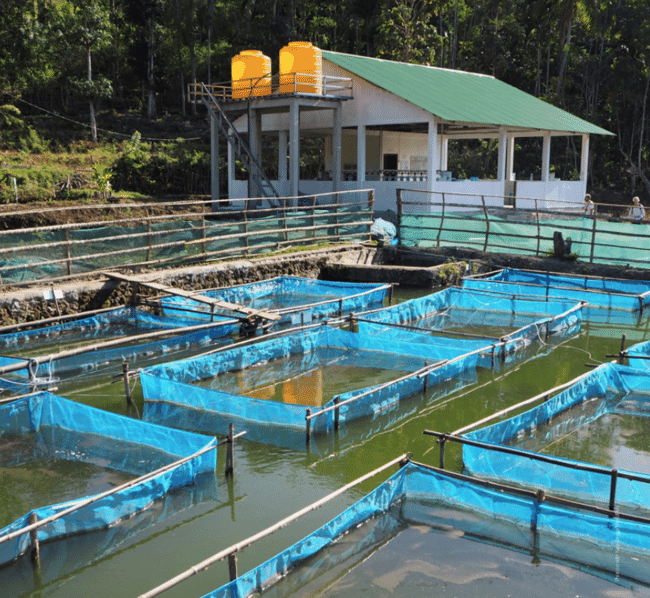
Average fish productivity during this cycle has increased three-fold compared to previous cycles
Prime Minister Taur Matan Ruak met with fish farmers in Leohitu, Bobonaro, and witnessed the harvesting of over six tonnes of farmed tilapia. The visit marks the start of the harvesting season for nearly 200 project farmers across Timor-Leste, which is expected to produce over 60 tonnes of fish from a nearly 5-hectare pond area. Average fish productivity during this cycle is estimated to reach over 12 tonnes per hectare—a three-fold increase in fish productivity compared to previous cycles.
“The government is committed to supporting the growth of aquaculture as a means to strengthen food security and nutrition for households and boosting incomes for farmers,” said the Prime Minister. “As the Covid-19 pandemic continues, fish farmers are producing locally-grown food and supporting a sustainable and robust food system that is putting more tilapia onto the plates of rural households.”
The event was organised by the Partnership for Aquaculture Development in Timor-Leste Phase 2 (PADTL2) project (April 2020–March 2023) funded by the New Zealand Ministry of Foreign Affairs and Trade ($3.2 million) and the United States Agency for International Development ($1.2 million in complementary funds). The project is implemented by WorldFish in partnership with the Timor-Leste Ministry of Agriculture and Fisheries.

By improving farmer access to GIFT tilapia, fish will be more widely available among rural households
The PADTL2 project, building on the solid foundation laid during the PADTL Phase 1, works to scale up the production of genetically improved farmed tilapia (GIFT) in Timor-Leste by improving farmer access to seed, feed and technologies. In turn, this will increase the availability and accessibility of fish and encourage greater fish consumption among rural households. The improved strain of tilapia that grows faster is achieved through selective breeding, a process used for millennia on crops and livestock.
The significant productivity gains achieved through the project are also due to the culture time being halved from 12 to six months through sustainable intensification of the production system, using high-quality fish feeds and in situ production of natural food (by making the water green). Farmers now could realise over 24 tonnes/ha of fish productivity annually by completing two production cycles—productivity comparable to the major tilapia-producing countries in Southeast Asia.
“Scaling out these promising technologies across the country is crucial for increasing the availability and accessibility of fish as a regular part of the Timorese diet,” said HE Philip Hewitt, New Zealand Ambassador to Timor-Leste. “Tilapia is full of micronutrients and essential fatty acids that are vital to good health and development, particularly in the first 1,000 days of a child’s life. Improving affordable supply will encourage more households to eat farmed tilapia to combat malnutrition in Timor-Leste.”
Over 400 participants representing government and non-governmental organisations, diplomatic missions, private sectors, fish farmers, fish market developers and local services providers (LSPs) attended the ceremony. The event included a tour of the MoreDoc Unipessoal Lda public-private-partnership (PPP) tilapia hatchery in Leohitu, the first PPP model GIFT hatchery in Timor-Leste. Since opening on 7 June 2019, the hatchery has produced over 2 million fingerlings and sold to farmers in Bobonaro and other municipalities and other non-governmental organizations.
“Strengthening fish farming will grow the incomes of local producers and strengthen food security and nutrition in Timor-Leste,” said US Chargé d'Affaires Tom Daley. “The United States is committed to partnering with Timor-Leste and New Zealand to accelerate local aquaculture development to expand prosperity and improve the health of the Timorese people.”

The four hatcheries will produce over 10 million fingerlings each year by 2023
The PADTL2 project inaugurated the second PPP hatchery in Parlamento, Lautem on 5 October 2021 and two more PPP hatcheries—in Hera, Dili, and Colocao, Manufahi—are under construction and due to be completed by the end of October 2022. It is expected the four PPP hatcheries will produce over 10 million fingerlings annually by 2023.
“The PADTL2 project supports progress toward the country’s National Aquaculture Development Strategy (2012–2030), creating employment and income opportunities for the citizens of Timor-Leste. The strategy targets increased farmed production of 12,000 tonnes per year by 2030, leading to a rise in annual fish consumption to 15 kg per person,” said WorldFish interim director general Essam Yassin Mohammed. “Connecting fish farmers with nutrition activities such as the school feeding programme and hospitals will support increased fish consumption to enhance public health outcomes.”




